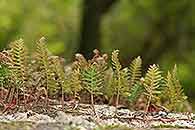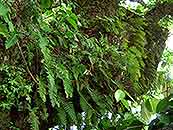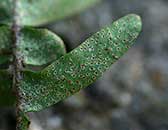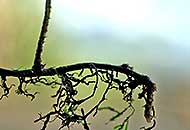Pleopeltis polypodioides (L.) E.G.Andrews & Windham ssp. ecklonii (Kunze) J.P.Roux
Synonyms |
Polypodium incanum sensu Sim |
|---|---|
Common name |
|
Description |
Rhizome long creeping, slender, C. 2 mm in diameter; rhizome scales dark brown, lanceolate, entire, appressed, c. 3mm long, with a dark area at the base. Fronds spaced apart (± 1 cm apart). Stipe up to 13 cm long; scales on stipe ovate, dark brown with pale margins, appressed, up to 2 mm long. Lamina up to 21 × 6.5 cm, lanceolate oblong to oblong-deltate in outline, pinnate to pinnatifid to near the midrib; lobes up to 2.5 x 0.4 cm, linear to narrowly oblong, entire, base broadly adnate, apex rounded: upper surface glabrous, lower surface set with round to broadly lanceolate, entire, peltate scales, c. 1 mm, grey to pale creamy brown with a dark centre; veins obscure, anastomising or free with terminal hydathodes. Sori round to oval, up to 12 per lobe, up to 1.5 mm in diameter, submarginal but protuding beyond the margin at maturity, produced in the upper half of the lobe, exindusiate, without paraphyses. |
Notes | Can be set aside from similar species by the peltate scales that are set on the undersurface of the pinate-pinnatifid lamina. |
Derivation | polypodioides: like Polypodium, ecklonii: named after C.F. Ecklon (1795-1868), a botanist whom collected in the Cape in South Africa during the 1830s. |
Habitat | Higher-rainfall areas in mist forest, low-altitude semideciduous forest and woodland. |
Distribution worldwide | See African distribution. |
Distribution in Africa |
Ethiopia, Malawi, Mozambique, South Africa, Swaziland, Tanzania , Zimbabwe. |
Growth form |
Epiphytic, lithophytic. |
Literature |
|





